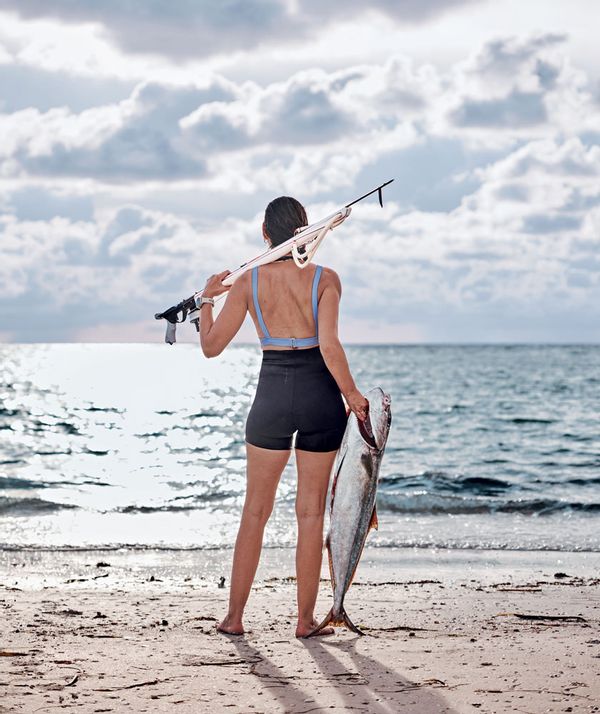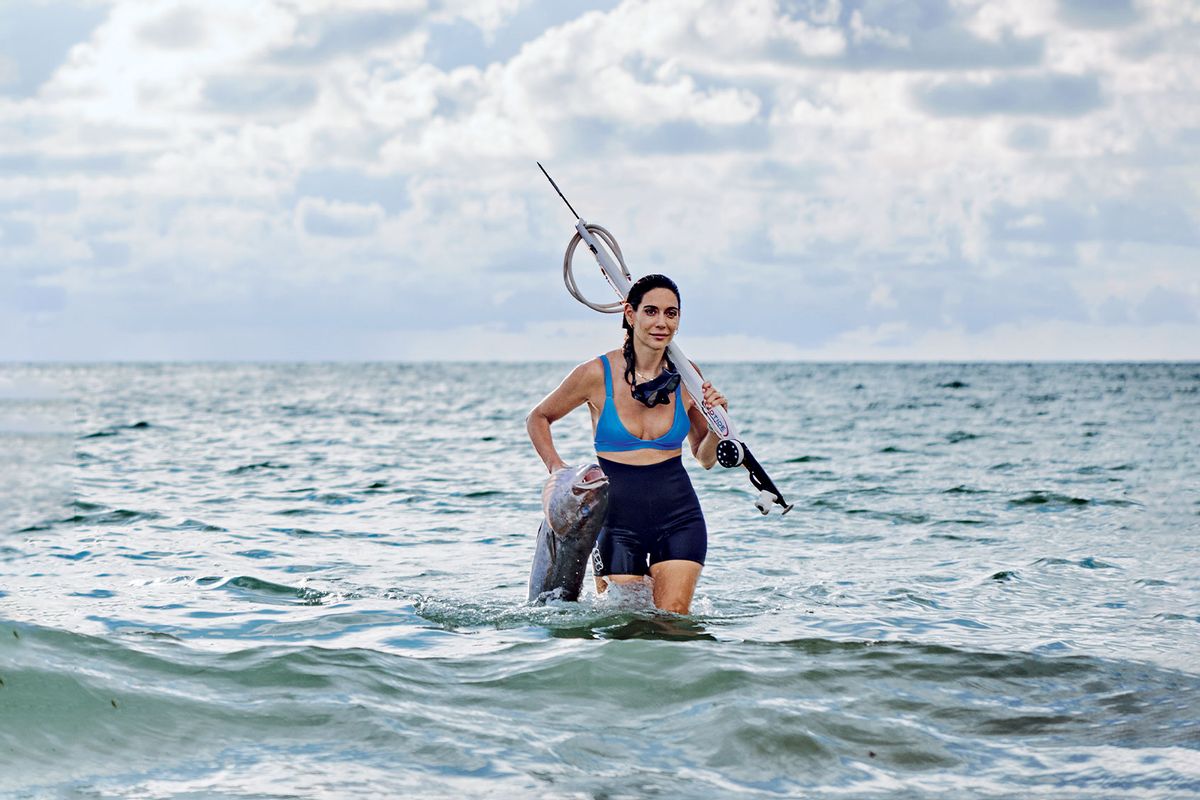For as long as I can remember, I've loved seafood.
Growing up, I thought that Red Lobster visits with my parents and brother were the pinnacle of cuisine. For some time there, though, I was mainly only fond of tuna, shrimp, crab, lobster, clams and mussels, but left the actual "fish fish" to the seas (except for when my mom made breaded fish "cutlets" because I'm nothing if not a creature of habit).
As I grew up, though, my palate expanded, I entered culinary school (which is where I tried my first oyster with a classmate's mom's homemade hot sauce and it was a moment, let me tell you) and worked in restaurants, broadening my sea horizons. Especially since giving up red meat a few years ago, seafood has had an even more profound hold on my diet.
I really, really love whenever something "tastes of the sea" . . . that light, simple, saline flavor that permeates the palate, sometimes veering into something akin to buttery, giving you that feeling that you're standing with your toes in the sand, gently lapped by the surf, peering out into the ocean. It's pretty unbeatable (I'm obviously partial to the Jersey shore, but that goes without saying).
So when I first read about Valentine Thomas, I knew I'd love to chat further with her. She is a fisherwoman, author, educator, cook and an advocate for sustainable fishery. She has a cookbook coming out shortly called "Good Catch: A Guide to Sustainable Fish and Seafood with Recipes from the World's Oceans," so in conjunction with its impending release, I reached out to Thomas to learn more about what exactly sustainable fishing really is, her favorite fish dishes and preparations and her overall insight into the seas and sustainability at large.
The following interview has been lightly edited for clarity and length.
Hi Valentine! It's said that your book combines message, memoir and cookery — what does that mean?
Spearfishing and catching your own food is so much more than just food and I wanted my book to transpire that. Through this lifestyle, I eliminated my anxiety, changed my life and values and discovered incredible food. And I wanted to share all of it.
I grew up scared of my own shadow, oblivious to where my food was from and believing that working in the corporate world was the only way to live. This book is not only my journey to the culinary world, but also a guide to live a free, caring and delicious life filled with ocean-conscious recipes.
The main takeaway, I guess, is: If I can do it, so can you. All of it.
How would you define "sustainable" in terms of fishery?
"Sustainable" has become a loose word in the last decade. When it comes to fisheries, I describe it as "fishing in a way that the generations to come can enjoy the same fish, at perpetuity". But in addition to this, also that it doesn't affect surrounding environments (food chain, bottom floor, etc).
Do you have a favorite fishing spot?
Living in Tampa for a few years, it grew to become my favorite fishing spot. With hundreds of artificial reefs, it is plentiful with various tasty species of fish. It is pretty shaky, but that makes it just more exciting!
 Valentine Thomas (Andrew Thomas Lee)
Valentine Thomas (Andrew Thomas Lee)
Did you grow up fishing?
I did not. Born and raised in Montreal, Quebec, I wasn't very outdoorsy growing up, which is why the lifestyle I chose is surprising for a lot of people around me. Strangely, it is not the fishing I fell in love with first, but the fish I was bringing back home.
What is your approach and ethos when it comes to cooking or preparing fish?
Use it all! A fish has so many good parts that are often discarded. From more popular parts such as head and collar to weirder ones like liver or visceral fat, fish has so much to offer flavor-wise. My friends are always skeptical when they come for dinner at my house (with reason, as I don't tell them what they ate until they are done!). For most fish, I'd pick the head and carcasses over the filets . . . it's that good.
Want more great food writing and recipes? Subscribe to Salon Food's newsletter, The Bite.
What fish do you most enjoy working with? Are there any fish that you think are "underrated," or conversely, any that are over-consumed?
I love working with "trash fish." A trash fish is a fish that is normally thrown back or considered as "not good enough meat." Not only do I always love a good challenge, but I also believe it can help with education and get people to get out of their comfort zone and try something different, while also relieving pressure on the more common species.
Are there any types of fish you avoid from an environmental or sustainable perspective?
It is more about the method and location than the species, I'd say. I believe it is very important to encourage the right practices. There are a lot of blanket statements going around such as "farmed salmon is bad" or "tuna fisheries are bad," when it is much more complex than that. I prioritize good farms, good fisheries and US caught fish (the US is a leader in sustainable fisheries). Eco-labels, while not perfect, are still a good indicator that you are buying the right stuff.
What are the issues with the carbon footprint of the commercial fishing industry?
Fish and seafood is the protein with the smallest carbon footprint. It has a lower carbon footprint than meat and cheese and is about equal to eggs. It also requires no land usage or fresh water. If sourced correctly, it is truly a great protein for the environment.
I love the book cover — what is the dish that's featured?
The cover is tuna sashimi on crispy rice cakes and harissa sauce. Perfect for guests . . . or just you, in front of the TV.
That sounds delicious. What are some of your other favorite recipes in the book?
It is like picking my favorite kid, I can't do that! I am joking; I have several favorites, though. The buttermilk fried fish on pancake, the Swedish fish soup and the fish tacos are probably my top three.
What are good tips for eating in an eco-friendly manner, both in regards to fish-centric diets and not?
It's a "tell me what you care about and I'll tell you what to eat" kind of thing! However, varying your diet (eat everything in moderation), eating local (national), source responsibly and let nothing go to waste are my go-tos. Although it can be perceived as a privileged way to look at things, the extra bucks for good products are often worth it. More than a Starbucks cup!
Do you have any tips on safely preparing raw fish dishes?
There are a few rules of thumbs here:
1. Never eat fresh water fish raw
2. Never eat wild salmon raw (yes, all raw salmon is farmed . . . see, it's not that bad!)
3. Freeze it first (or ask if it was previously frozen)
4. Ask your fish monger if it can be eaten raw
5. Buy sushi grade (which merely means it was flash frozen, most probably on the boat)
6. When in doubt, cook it, you'll regret it later that night if it wasn't intended to be eaten raw
And last but not least: Buy a great book called "Good Catch" for tips on how to prepare raw fish dish, how to build your own recipes made for you and what constitutes most raw fish dishes.
Read more
about fish and seafood:
Salon Food writes about stuff we think you'll like. While our editorial team independently selected these products, Salon has affiliate partnerships, so making a purchase through our links may earn us a commission.



Shares